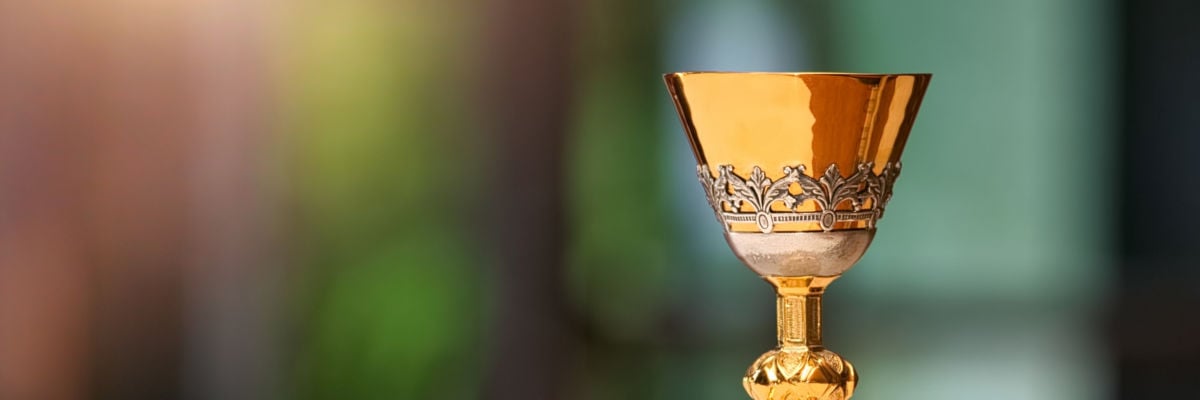
As Catholics, we believe that a miracle occurs at every Mass: bread and wine truly become Jesus Christ—body, blood, soul, and divinity—while seeming, according to the senses, to remain bread and wine. This is the quintessential eucharistic miracle. What people typically mean when using that term, however, is some sort of physical manifestation of that reality: the bread visibly becomes human flesh, blood pours from the host, etc.
There have been dozens, even hundreds, of spectacularly documented eucharistic miracles through the centuries. While it is hard to scientifically verify such miracles (did the blood actually come from the host? Was this cardiac tissue actually initially a piece of unleavened bread?), there is an ever-increasing corpus of Eucharistic miracles, which have helped many people come to a stronger faith in the Real Presence of Christ in the Eucharist.
The Holy Sacrifice of the Mass is sometimes referred to as an unbloody sacrifice, re-presenting Christ’s sacrifice on Calvary, but without the visible manifestation of the Precious Blood. In honor of this month traditionally dedicated to reverencing the Most Precious Blood of Jesus Christ, we are going to look at a few eucharistic miracles where blood played a significant role.
Perhaps the most famous, or at least often considered the quintessential, eucharistic miracle occurred in Lanciano, Italy in the eighth century. A priest in that city was having doubts about the Real Presence of Christ in the Eucharist. As he was saying Mass one day, at the words of consecration, the bread and wine transformed into flesh and blood—even according to the senses. To this day, the flesh and blood are preserved, and on display, after more than twelve hundred years.
In the twentieth century, the preserved physical specimen of this miracle was subjected to rigorous scientific investigations. The World Health Organization, the United Nations, and others conducted studies. It was determined that the flesh is cardiac tissue, specifically from the left ventricle of the heart, and by all appearances, the blood appeared to be fresh, certainly not over a millennium old. The blood type was identified as AB, which is identical to the blood type on the Shroud of Turin and consistently identified as the type in eucharistic miracles involving the Precious Blood. In 1976, the World Health Organization and United Nations released the results of their study. As the summary of the results available at therealpresence.org puts it: “Science, aware of its limits, has come to a halt, face to face with the impossibility of giving an explanation.”
In 1263, a German priest named Peter of Prague was struggling with doubts about the teaching on transubstantiation. As he said Mass, at the words of consecration, blood began to stream from the host, dripping onto the corporal on the altar. Pope Urban IV investigated this occurrence and determined it to be an authentic miracle. The bloodstained corporal is still on display in the cathedral in Orvieto, Italy.
This miracle had a long-lasting impact, which has affected the entire universal Church: it prompted Pope Urban IV to establish a new liturgical feast, Corpus Christi, celebrating the body and blood of Christ. To compose the liturgical texts for this feast (both for the Mass and for the Liturgy of the Hours), the pope chose St. Thomas Aquinas. Now this feast is a remarkable commemoration of the Church’s eucharistic faith, marked all over the world by spectacular processions, carrying the Eucharist through the streets and out into the world.
While there are hundreds of documented eucharistic miracles, most were not tested with modern scientific equipment and methodology. In the 1990s, this changed, right as there was a sudden surge of eucharistic miracles. The results continue to be astounding.
Two of these miracles occurred in the early 1990s in Buenos Aires, Argentina. In 1992 and 1996, hosts were put into water to be dissolved. This is dictated by the Church as the proper way to dispose of consecrated hosts that are not to be consumed, usually because they have fallen on the floor or something like that. In both cases, when someone returned to check on the status of the dissolving host, it was found later to have turned into a bloody substance in the water. Again, these were both investigated thoroughly through modern scientific methods, and no earthly explanation could be found. Interestingly, both cases happened while Jorge Bergoglio, the future Pope Francis, was an auxiliary bishop of Buenos Aires. (He would later become archbishop.)
Some of the details that scientific investigations have discovered in these miracles are remarkable—and consistent. The blood is human blood, type AB, with all signs of recent life—or sometimes current life. On some occasions, a bleeding host will exhibit a clot on the outside but fresh blood on the inside, as with a wound in the process of healing. The flesh comes from the left ventricle of the heart and typically shows signs of trauma and even impending death.
As Catholics, we do not need science to tell us something is miraculous in order for us to believe it. Scientific investigation can and does often come to a dead end when examining something miraculous, because that’s the point: in a miracle the laws of nature are suspended or upended. But eucharistic miracles such as those discussed here, and the countless other examples out there, reaffirm the Church’s teaching and put on full display for all the world a visible sign of the miracle that happens at every Mass. The words of Jesus Christ are eternally efficacious, and at all hours of the day, all over the world, bread and wine become Jesus Christ, body, blood, soul, and divinity, while appearing to remain as bread and wine according to the senses. From time to time, the senses can be used to confirm this reality.
There are a few different situations that seem to prompt these eucharistic miracles over the centuries. Sometimes it is to prevent the desecration of a host, but the most common reason for such miracles seems to be doubt in the Real Presence, especially from a priest. Perhaps this is why eucharistic miracles seem to have greatly increased in number in the last thirty years or so. We know that belief in the Real Presence is plummeting; many Catholics could not even articulate the Church’s teaching, let alone give their assent to it. Eucharistic miracles, particularly those involving the Precious Blood, really help to encourage eucharistic faith and devotion to the Blessed Sacrament.



